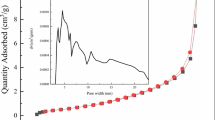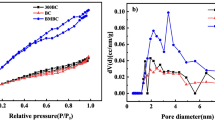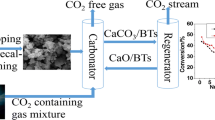Abstract
The treatment of beryllium wastewater has become a major problem in industry. In this paper, CaCO3 is creatively proposed to treat beryllium-containing wastewater. Calcite was modified by an omnidirectional planetary ball mill by a mechanical−chemical method. The results show that the maximum adsorption capacity of CaCO3 for beryllium is up to 45 mg/g. The optimum treatment conditions were pH = 7 and the amount of adsorbent was 1 g/L, and the best removal rate was 99%. The concentration of beryllium in the CaCO3-treated solution is less than 5 μg/L, which meets the international emission standard. The results show that the surface co-precipitation reaction between CaCO3 and Be (II) mainly occurs. Two different precipitates are generated on the used-CaCO3 surface; one is the tightly connected Be (OH)2 precipitation, and the other is the loose Be2(OH)2CO3 precipitation. When the pH of the solution exceeds 5.5, Be2+ in the solution is first precipitated by Be (OH)2. After CaCO3 is added, CO32- will further react with Be3(OH)33+ to form Be2(OH)2CO3 precipitation. CaCO3 can be considered as an adsorbent with great potential to remove beryllium from industrial wastewater.
Graphical abstract









Similar content being viewed by others
References
Abd MO, El-Magied AM, Al FA, Alsayed G, Eldayem SA (2018a) Biosorption of beryllium from aqueous solutions onto modified chitosan resin: equilibrium, kinetic and thermodynamic study. J Dispers Sci Technol 11. https://doi.org/10.1080/01932691.2018.1452757
Abd MO, El-Magied AM, Al FA, Alsayed G, Eldayem SA (2018b) Biosorption of beryllium from aqueous solutions onto modified chitosan resin: equilibrium, kinetic and thermodynamic study. J Dispers Sci Technol 11. https://doi.org/10.1080/01932691.2018.1452757
Abdulkadir I, Mohammed BS, Liew MS, Wahab MMA (2021) Modelling and multi-objective optimization of the fresh and mechanical properties of self-compacting high volume fly ash ECC (HVFA-ECC) using response surface methodology (RSM). Case Studies in Construction Materials 14:e00525. https://doi.org/10.1016/j.cscm.2021.e00525
Ali I, Singh P, Aboul-Enein HY, Sharma B (2009) Chiral analysis of ibuprofen residues in water and sediment. Anal Lett 42(12):1747–1760. https://doi.org/10.1080/00032710903060768
Ali I, Burakov AE, Melezhik AV, Babkin AV, Burakova IV, Neskomornaya MEA et al (2019b) Removal of copper (II) and zinc (II) ions in water on a newly synthesized polyhydroquinone/graphene nanocomposite material: kinetics, thermodynamics and mechanism. ChemistrySelect 4(43):12708–12718. https://doi.org/10.1002/slct.201902657
Ali I, Burakova I, Galunin E, Burakov A, Mkrtchyan E, Melezhik A, Grachev V (2019c) High-speed and high-capacity removal of methyl orange and malachite green in water using newly developed mesoporous carbon: kinetic and isotherm studies. ACS omega 4(21):19293–19306. https://doi.org/10.1021/acsomega.9b02669
Ali I, Kucherova A, Memetov N, Pasko T, Ovchinnikov K, Pershin V et al (2019a) Advances in carbon nanomaterials as lubricants modifiers. J Mol Liq 279:251–266. https://doi.org/10.1016/j.molliq.2019.01.113
Ali I, Afshinb S, Poureshgh Y, Azari A, Rashtbari Y, Feizizadeh A, Fazlzadeh M (2020) Green preparation of activated carbon from pomegranate peel coated with zero-valent iron nanoparticles (nZVI) and isotherm and kinetic studies of amoxicillin removal in water. Environ Sci Pollut Res 27:36732–36743. https://doi.org/10.1007/s11356-020-09310-1
Ali I, Babkin AV, Burakova IV, Burakov AE, Neskoromnaya EA, Tkachev AG et al (2021b) Fast removal of samarium ions in water on highly efficient nanocomposite based graphene oxide modified with polyhydroquinone: isotherms, kinetics, thermodynamics and desorption. J Mol Liq 329:115584. https://doi.org/10.1016/j.molliq.2021.115584
Ali I, Kon'kova T, Kasianov V, Rysev A, Panglisch S, Mbianda XY et al (2021a) Preparation and characterization of nano-structured modified montmorillonite for dioxidine antibacterial drug removal in water. J Mol Liq 331:115770. https://doi.org/10.1016/j.molliq.2021.115770
Atkins P, Overton T (2010) Shriver and Atkins’ inorganic chemistry. Oxford University Press, USA ISBN 978-0199236176
Basheer AA (2018a) New generation nano-adsorbents for the removal of emerging contaminants in water. J Mol Liq 261:583–593. https://doi.org/10.1016/j.molliq.2018.04.021
Basheer AA (2018b) Chemical chiral pollution: impact on the society and science and need of the regulations in the 21st century. Chirality 30(4):402–406. https://doi.org/10.1002/chir.22808
Basheer AA (2020) Advances in the smart materials applications in the aerospace industries. Aircr Eng Aerosp Technol 92(7):1027–1035. https://doi.org/10.1108/AEAT-02-2020-0040
Basheer AA, Ali I (2018) Stereoselective uptake and degradation of (±)-o, p-DDD pesticide stereomers in water-sediment system. Chirality 30(9):1088–1095. https://doi.org/10.1002/chir.22989
Çam Kaynar S, Kaynar ÜH (2019) Method for the determination of polonium-210 in tea samples using response surface methodology (RSM). Nucl Sci Tech 30(3):1–7. https://doi.org/10.1007/s41365-019-0567-5
Chen L, Kaiser A, Probst M, Shermukhamedov S (2020) Sputtering of the beryllium tungsten alloy Be2W by deuterium atoms: molecular dynamics simulations using machine learned forces. Nuclear Fusion 61(1):016031. https://doi.org/10.1088/1741-4326/abc9f4
Chiarappa-Zucca ML, Finkel RC, Martinelli RE, McAninch JE, Nelson DO, Turteltaub KW (2004) Measurement of beryllium in biological samples by accelerator mass spectrometry: applications for studying chronic beryllium disease. Chem Res Toxicol 17(12):1614–1620. https://doi.org/10.1021/tx049883o
Dan Y, Xu L, Qiang Z, Dong H, Shi H (2021) Preparation of green biosorbent using rice hull to preconcentrate, remove and recover heavy metal and other metal elements from water. Chemosphere 262:127940. https://doi.org/10.1016/j.chemosphere.2020.127940
Deng S, Chen Y (2019) A study by response surface methodology (RSM) on optimization of phosphorus adsorption with nano spherical calcium carbonate derived from waste. Water Sci Technol 79(1):188–197. https://doi.org/10.2166/wst.2019.048
Dhyani V, Kumar J, Bhaskar T (2017) Thermal decomposition kinetics of sorghum straw via thermogravimetric analysis. Bioresour Technol 245:1122–1129. https://doi.org/10.1016/j.biortech.2017.08.189
Di Lorenzo F, Cametti G, Vanhecke D, Churakov SV (2020) The role of interfaces in controlling Pb2+ removal by calcium carbonate minerals. Cryst Growth Des 20(9):6157–6169. https://doi.org/10.1021/acs.cgd.0c00906
Fiorito E, Porcedda GE, Brundu L, Passiu C, Atzei D, Ennas G et al (2022) Calcium carbonate as sorbent for lead removal from wastewaters. Chemosphere 296:133897. https://doi.org/10.1016/j.chemosphere.2022.133897
Gang R, Yan Y et al (2016) Adsorption of beryllium (Be) from wastewater by chitosan modified zeolite [J]. J Saf Environ 16(6):208–213. https://doi.org/10.1016/J.BIORTECH.2021.125238
Gatewood PL, Sneddon J (1990) Removal and recovery of beryllium in waters by chlorella vulgaris [J]. Journal of Environmental Science and Health Part A 25(1):21–28. https://doi.org/10.1080/10934529009375537
Ghosh I, Sharma C, Tandon R (2018) Role of additives to improve adsorption of xylan on precipitated calcium carbonate. Cellulose 25(3):1583–1598. https://doi.org/10.1007/s10570-018-1666-x
Guo ML (2012) Thinking of emergency response law for environmental pollution incidents -- from the perspective of heavy metal pollution [J]. Journal of **angnan University 33(4):32–36
Heshan Z, Wanqian G, Shuo L, Jo-Shu C (2017) Adsorption of p-nitrophenols (PNP) on microalgal biochar: analysis of high adsorption capacity and mechanism. Bioresource Technology 2. https://doi.org/10.1016/j.biortech.2017.05.025
Hu J, Geng X, Duan Y, Zhao W, Zhu M, Ren S (2020) Effect of mechanical–chemical modification process on mercury removal of bromine modified fly ash. Energy Fuel 34(8):9829–9839. https://doi.org/10.1021/acs.energyfuels.0c01509
Iwatsubo T, Kishi R, Yamaguchi T (2019) Calcium carbonate skeletal material is synthesized via phase transition of the calcium carbonate cartilaginous material. ACS omega 4(12):14820–14830. https://doi.org/10.1016/j.matchemphys.2021.125025
Jia Y, Li YN, Wang ZM, Li FM, ** PJ, Li SN, Chen Y (2021) Porous cobalt carbonate hydroxide nanospheres towards oxygen evolution reaction. Chem Eng J 417:128066. https://doi.org/10.1016/j.cej.2020.128066
Keogh W, Neville A, Liu Q, Feng L, ** C, Nielsen FM et al (2020) Lead sulfide scaling in multiphase systems and co-precipitation in the presence of calcium carbonate. J Pet Sci Eng 188:106919. https://doi.org/10.1016/j.petrol.2020.106919
Kilinc E, Bakirdere S, Yaman M (2011) Trace level determination of beryllium in natural and flavored mineral waters after pre-concentration using activated carbon [J]. Food Additives and Contaminants Part a-Chemistry Analysis Control Exposure &Risk Assessment 4(28):455–460. https://doi.org/10.1080/19440049.2011.551946
LI CX (2010) Study on engineering technology of Biologic treatment of beryllium wastewater [D]. Central South University. https://kns.cnki.net/KCMS/detail/detail.aspx?dbname=CMFD2011&filename=2010190301.nh
Li XG, Lv Y, Ma BG, Wang WQ, Jian SW (2017) Decomposition kinetic characteristics of calcium carbonate containing organic acids by TGA. Arab J Chem 10:S2534–S2538. https://doi.org/10.1016/j.arabjc.2013.09.026
Lopez-Heredia MA, Łapa A, Reczyńska K, Pietryga K, Balcaen L, Mendes AC et al (2018) Mineralization of gellan gum hydrogels with calcium and magnesium carbonates by alternate soaking in solutions of calcium/magnesium and carbonate ion solutions. J Tissue Eng Regen Med 12(8):1825–1834. https://doi.org/10.1002/term.2675
Martins AC, Pezoti O et al (2015) Removal of tetracycline by NaOH-activated carbon produced from macadamia nut shells: kinetic and equilibrium studies [J]. Chem Eng J 260:291–299. https://doi.org/10.1016/j.cej.2014.09.017
Millett JCF, Whiteman G, Park NT, Case S, Appleby-Thomas G (2019) The effects of heat treatment upon the shock response of a copper-beryllium alloy. Acta Mater 165:678–685. https://doi.org/10.1016/j.actamat.2013.01.021
Minglong Z, Liyuan C et al (2006) Adsorption and desorption of Beryllium in wastewater by activated sludge [J]. Technology of Water Treatment 02:45–48. https://doi.org/10.16796/j.cnki.1000-3770.2006.02.014
Wu Minzhan, Zhang Zhengke, Chen Sili,et al. (2021). Experimental study on screening of emergency adsorption materials for sudden beryllium pollution in water body. Technology of Water Treatment ,47(05) : 78-82. https://doi.org/10.16796/j.cnki.1000-3770.2021.05.016.
Peizhen Z, **aoxiao Z, **angru Y, Ruyue X, Lujia H (2021) Characteristics, adsorption behaviors, Cu (II) adsorption mechanisms by cow manure biochar derived at various pyrolysis temperatures. Bioresour Technol 331. https://doi.org/10.1016/J.BIORTECH.2021.125013
Petanová J, Bencko V (2020) Health aspects of exposure to emissions from burning coal of high beryllium content: interactions with the immune system [J]. Cent Eur J Public Health 128(3):198–201. https://doi.org/10.21101/cejph.a5851
Polowczyk I, Bastrzyk A, Fiedot M (2016) Protein-mediated precipitation of calcium carbonate Materials 9(11):944. https://doi.org/10.3390/ma9110944
Powell KJ, Brown PL, Byrne RH, Gajda T, Hefter G, Leuz AK, Wanner H (2009) Chemical speciation of environmentally significant metals with inorganic ligands. Part 3: the Pb2++ OH–, Cl–, CO32–, SO42–, and PO43– systems (IUPAC Technical Report). Pure Appl Chem 81:2425–2476. https://doi.org/10.1351/PAC-REP-09-03-05
Savenko VS (2007) Be2(OH)2CO3 solubility in carbonate and fluoride aqueous solutions. Russ J Inorg Chem 52(3):465–467. https://doi.org/10.1134/S0036023607030291
Sengupta AK (1964) Basic beryllium complex carbonates. J Inorg Nucl Chem 26(11):1823–1828. https://doi.org/10.1016/0022-1902(64)80006-3
Senthil Kumar P, Dinesh Kirupha S et al (2011) Adsorption behavior of nickel (II) onto cashew nut shell: equilibrium,thermodynamics, kinetics, mechanism and process design [J]. Chem Eng J 167:122–131. https://doi.org/10.1016/j.cej.2010.12.010.Powell
Shannon RD (1976) Revised effective ionic radii and systematic studies of interatomic distances in halides and chalcogenides. Acta Crystallogr. Sect. A Cryst. Phys Diffr Theor Gen Crystallogr 32:751–767. https://doi.org/10.1107/S0567739476001551
Shchukarev AV, Korolkov DV (2004) XPS study of group IA carbonates. Cent Eur J Chem 2(2):347–362. https://doi.org/10.2478/BF02475578
Simonič M, Goričanec D, Urbancl D (2021) Influence of pressure and Mg2+ ions on crystalline properties of calcium carbonate. J Mol Liq 334:116462. https://doi.org/10.1016/j.molliq.2021.116462
Sun F, Sun WL et al (2011) Biosorption behavior and mechanism of beryllium from aqueous solution by aerobic granule [J]. Chem Eng J 172(2-3):783–791. https://doi.org/10.1016/j.cej.2011.06.062
Tanveer M, Wang L (2019) Potential targets to reduce beryllium toxicity in plants: a review. Plant Physiol Biochem 139. https://doi.org/10.1016/j.plaphy.2019.04.022
Tao XY, **e L et al (2020) Mineralogical characteristics of beryl: a case study of the beryls from Cuona and Qomolangma district in Himalaya [J]. Journal of Nan**g University (Natural Science) 56(6):815–829
Thakur SK, Tomar NK, Pandeya SB (2006) Influence of phosphate on cadmium sorption by calcium carbonate. Geoderma 130(3-4):240–249. https://doi.org/10.1016/j.geoderma.2005.01.026
Tokarčíková M, Motyka O, Peikertová P, Gabor R, Seidlerová J (2021) Magnetically modified biosorbent for rapid beryllium elimination from the aqueous environment. Materials 14(21):6610. https://doi.org/10.3390/ma14216610
Usui K, Yokota SI, Ozaki M, Sakashita S, Imai T, Tomizaki KY (2018) Modification of the N-terminus of a calcium carbonate precipitating peptide affects calcium carbonate mineralization. Protein Pept Lett 25(1):42–47. https://doi.org/10.2174/0929866525666171221114658
Vickerman JC, Gilmore IS (eds) (2011) Surface analysis: the principal techniques. John Wiley & Sons ISBN 978-0470017630
Yu L, Wang Z, Wu J, Meng X, Lai X (2019) Microstructure and properties of vacuum cast Sc-containing Be–Al alloys. Int J Met 13(1):201–212. https://doi.org/10.1007/s40962-018-0249-9
Yücel Y, Göycıncık S (2015) Optimization and modelling of process conditions using response surface methodology (RSM) for enzymatic saccharification of spent tea waste (STW). Waste and biomass valorization 6(6):1077–1084. https://doi.org/10.1007/s12649-015-9395-y
Zeng C, Hu H, Feng X, Wang K, Zhang Q (2020) Activating CaCO3 to enhance lead removal from lead-zinc solution to serve as green technology for the purification of mine tailings. Chemosphere 249:126227. https://doi.org/10.1016/j.chemosphere.2020.126227
Zhao X, Su Y, Wang H, Lei Z, Hu E, Hu F et al (2023) Modification of activated carbon from agricultural waste lotus leaf and its adsorption mechanism of beryllium. Korean J Chem Eng 40(1):255–266. https://doi.org/10.1007/s11814-022-1251-8
Zhao X, Yucheng S, Zhiwu L, Hongqiang W, Eming H, Fang H, Xuanzhang H (2022) Adsorptive removal of beryllium by Fe-modified activated carbon prepared from lotus leaf. Environ Sci Pollut Res 1-14. https://doi.org/10.1007/s11356-022-23415-9
Zheng Z, Tokunaga TK, Wan J (2003) Influence of calcium carbonate on U (VI) sorption to soils. Environ Sci Technol 37(24):5603–5608. https://doi.org/10.1021/es0304897
Zhou X, Liu W, Tian C, Mo S, Liu X, Deng H, Lin Z (2018) Mussel-inspired functionalization of biological calcium carbonate for improving Eu (III) adsorption and the related mechanisms. Chem Eng J 351:816–824. https://doi.org/10.1016/j.cej.2018.06.142
Availability of data and material
All data generated or analyzed during this study are included in this published article (and its supplementary information files).
Funding
This study was funded by the Foundation of State Key Laboratory of Nuclear Resources and Environment (2020NRE02) and Ministry of Science and Technology of China (2019YFC1907701).
Author information
Authors and Affiliations
Contributions
All authors contributed to the study conception and design. Material preparation, data collection, and analysis were performed by Xu Zhao, Zhiwu Lei, Xuanzhang Hao, Yucheng Su, Hongqiang Wang, Eming Hu, Fang Hu, Qingliang Wang, Lechang Xu, Chunze Zhou, Shiyao Fan, **nwei Liu, and Shuai Dong. The first draft of the manuscript was written by Xu Zhao, and all authors commented on previous versions of the manuscript. All authors read and approved the final manuscript.
Corresponding author
Ethics declarations
Consent for publication
This is not applicable.
Conflict of interest
The authors declare no competing interests.
Additional information
Responsible Editor: Tito Roberto Cadaval Jr
Publisher’s note
Springer Nature remains neutral with regard to jurisdictional claims in published maps and institutional affiliations.
Rights and permissions
Springer Nature or its licensor (e.g. a society or other partner) holds exclusive rights to this article under a publishing agreement with the author(s) or other rightsholder(s); author self-archiving of the accepted manuscript version of this article is solely governed by the terms of such publishing agreement and applicable law.
About this article
Cite this article
Zhao, X., Su, Y., Hao, X. et al. Effect of mechanical−chemical modification on adsorption of beryllium by calcite. Environ Sci Pollut Res 30, 125241–125253 (2023). https://doi.org/10.1007/s11356-023-27275-9
Received:
Accepted:
Published:
Issue Date:
DOI: https://doi.org/10.1007/s11356-023-27275-9




